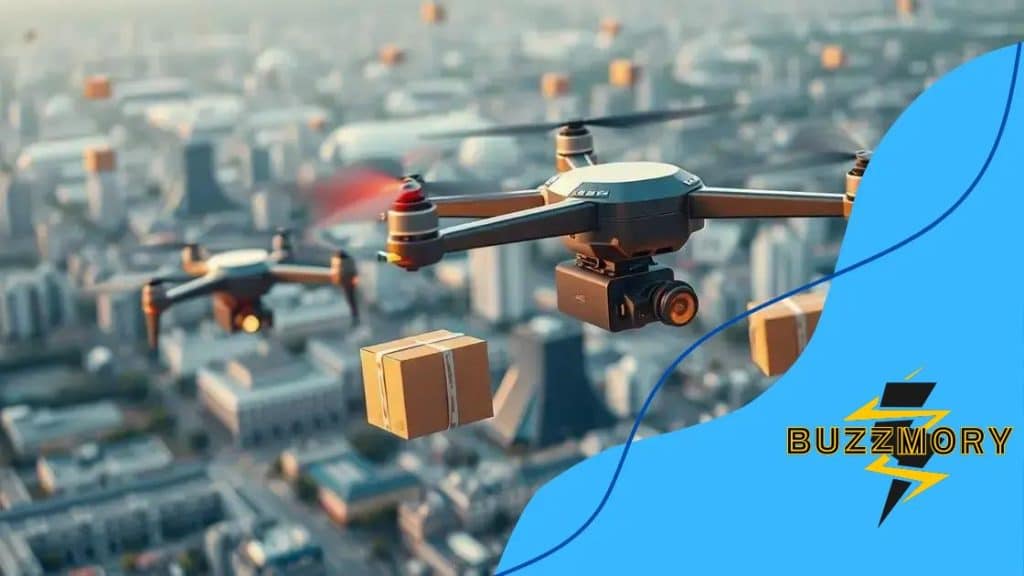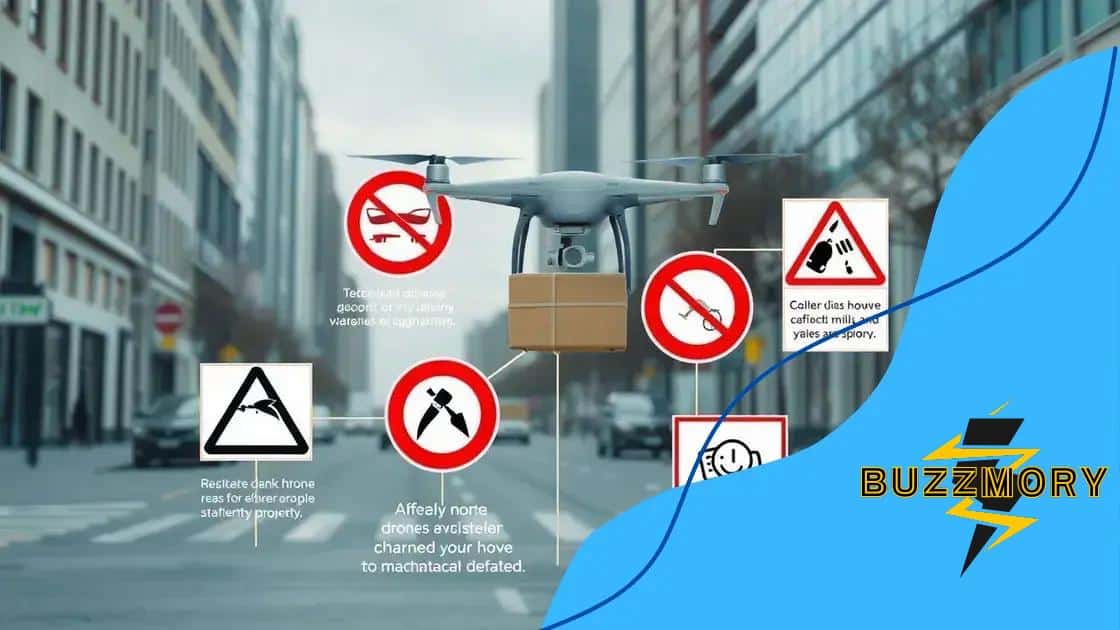How drones are transforming logistics and delivery services

Drones are transforming logistics and delivery services by improving efficiency, reducing costs, and enabling fast deliveries, while facing challenges such as regulations and safety concerns.
How drones are transforming logistics and delivery services is a question many are asking as this technology reshapes our world. Have you noticed the impact they’re having on how goods are delivered? In this article, we’ll dive into the remarkable ways drones are changing the logistics landscape.
The evolution of drone technology
The evolution of drone technology has been remarkable over the years. From simple remote-controlled toys to highly sophisticated machines, drones have advanced significantly. This technology not only captures stunning imagery but also plays a vital role in various industries.
Early Beginnings
Initially, drones were mainly used for military purposes. They provided surveillance and targeted operations. However, as technology improved, researchers began to explore new applications. Today, many industries are benefiting from drone technology.
Commercial Use
In recent years, the commercial sector has embraced drones. They are now used in agriculture, real estate, and logistics. Drones help farmers monitor crops and assess health. In real estate, aerial photos can showcase properties effectively. Logistics companies are also testing drones for rapid delivery.
- Increased efficiency in delivery services
- Cost-effective solutions for businesses
- Real-time data collection for various applications
The flexibility of drones makes them valuable across numerous fields. As their capabilities continue to expand, we can expect further integration into daily operations.
Technological Advancements
With ongoing research, we see continuous improvements in drone capabilities. Better batteries, enhanced sensors, and advanced AI are driving these advancements. The future looks bright for drone technology as it becomes more accessible to businesses and individuals.
Overall, the journey of drones from military tools to multifunctional devices illustrates their vast potential. Their evolution is pivotal for next-generation logistics and delivery services, enabling faster and more efficient operations.
Benefits of drones in logistics
The benefits of drones in logistics have become increasingly apparent as industries adopt this innovative technology. Drones are changing how goods are transported, making processes faster and more efficient. They offer unique advantages that can optimize logistics operations significantly.
Speed and Efficiency
Drones can deliver packages much faster than traditional methods. With their ability to bypass traffic and reach remote locations, they reduce delivery times dramatically. This speed is crucial, especially for urgent deliveries, helping businesses meet customer expectations.
Cost Savings
Utilizing drones can lower transportation costs. Companies save money on fuel and labor, as drones autonomously deliver products. The initial investment may be significant, but the long-term savings are often worth it. Businesses can allocate resources more efficiently in other areas.
- Reduction in delivery times leads to improved customer satisfaction.
- Lower operational costs compared to ground transportation.
- Less environmental impact due to decreased emissions.
The deployment of drones also minimizes human error, enhancing accuracy in deliveries. As they follow programmed routes, the likelihood of misdelivery decreases substantially. Furthermore, drones can operate in various weather conditions, ensuring that deliveries continue seamlessly.
Data Collection and Monitoring
Drones are equipped with advanced sensors, enabling them to gather valuable data. This capability is crucial in logistics as it allows for real-time monitoring of inventory and shipment status. Businesses can track their deliveries more effectively, providing transparency to customers.
The ongoing advancements in drone technology promise even more benefits for logistics in the future. As the industry continues to evolve, it’s clear that incorporating drones can lead to a more efficient and cost-effective logistics ecosystem.
Challenges faced by drone delivery services

The challenges faced by drone delivery services are significant as the industry seeks to expand. While drones offer many advantages, several hurdles need to be addressed for widespread adoption. Understanding these challenges is essential for improving the technology and regulations surrounding drone deliveries.
Regulatory Issues
One of the main challenges is navigating regulatory frameworks. Each country has different laws governing air traffic and drone usage. Companies must often obtain permits and comply with strict regulations, which can slow down deployment. This complexity makes it difficult for businesses to operate across borders.
Safety Concerns
Safety is another major issue. Drones can pose risks to people and property if they malfunction. Ensuring that drones can operate safely in urban environments is vital. Companies are investing in safety features, but accidents can still happen, raising public concerns.
- Potential for mid-air collisions with other aircraft.
- Risk of crashes due to technical failures.
- Concerns about invasion of privacy for individuals.
These safety concerns often lead to pushback from communities and regulatory bodies. Educating the public about safety measures and benefits is essential to gaining acceptance.
Technical Limitations
Technical limitations also hinder the growth of drone delivery services. Battery life is a critical factor that restricts flight distance and delivery time. Drones equipped with heavier payloads may require more energy, making efficient delivery more challenging. Weather conditions can further limit operations, as many drones cannot fly in high winds or rain.
To overcome these challenges, ongoing research and development are crucial. Advancements in battery technology and flying capabilities will be key to the future of drone delivery services. As the industry evolves, addressing these challenges will help unlock the full potential of drones in logistics.
Future trends in drone logistics
The future trends in drone logistics are promising as technology continues to advance. Drones are becoming more efficient and integrated into various aspects of delivery services. As companies explore new possibilities, we can expect several key developments in this field.
Increased Autonomy
One of the most significant trends is the move towards greater autonomy. Future drones will have better navigation systems, allowing them to operate with minimal human intervention. This will enhance efficiency and reduce labor costs, making drone delivery more appealing to businesses.
Improved Delivery Networks
As drone technology evolves, so will the delivery networks. We could see a system where drones work alongside ground vehicles for seamless logistics solutions. Hybrid models may emerge, combining traditional trucks with drones for last-mile delivery. This approach can lead to faster service and more reliable deliveries.
- Integration into existing supply chains.
- Utilization of urban air mobility solutions.
- Partnerships between logistics companies and drone manufacturers.
Furthermore, advancements in battery technology will allow drones to cover longer distances without needing a recharge. This appears crucial for expanding their reach into rural and remote areas. Customers can expect quicker deliveries even in less accessible regions.
Data Utilization and Analytics
Another exciting trend is the increased use of data analytics. Drones generate vast amounts of information as they operate. Companies will leverage this data to optimize routes, predict demand, and enhance inventory management. Using artificial intelligence will further enhance these capabilities.
As regulations evolve, the growth of drone logistics will pave the way for new business models. Companies are beginning to recognize the value of these innovations and explore how they can improve their operations. As drone technology continues to develop, it will reshape the very nature of logistics and delivery services.
Real-world applications and success stories
Real-world applications and success stories of drones in logistics highlight the effectiveness of this technology across various sectors. Companies are increasingly adopting drones to enhance their delivery services, demonstrating tangible benefits and innovative solutions.
Delivery Services
Major delivery companies are testing and implementing drone technology to improve speed and efficiency. For instance, Amazon Prime Air has been developing a system where drones can deliver packages within hours of an order being placed. This innovation has the potential to revolutionize how products reach customers.
Agricultural Monitoring
Drones are also making waves in agriculture, where farmers use them for monitoring crop health. Companies like PrecisionHawk provide drones equipped with sensors to gather data on soil health and plant conditions. This information allows farmers to make data-driven decisions, increasing yield and reducing waste.
- Utilization of aerial imagery for crop assessment.
- Efficient pesticide and fertilizer application.
- Real-time data collection for better resource management.
As farmers adopt drone technology, they experience significant improvements in productivity and sustainability. This shift showcases how drones can create value in agriculture, beyond just logistics.
Emergency Services
Drones are increasingly valuable in emergency services, providing rapid assessment during disasters. Drones can reach areas that are hard to access, delivering critical supplies or capturing images to help coordinate rescue efforts. For example, Zipline successfully uses drones to deliver blood, vaccines, and medical supplies to remote locations in countries like Rwanda and Ghana.
Such applications demonstrate the enormous potential of drone technology to save lives and enhance operational efficiency in critical situations. As more industries embrace drones, the stories of success will continue to grow, driving further innovations and applications in logistics.
FAQ – Frequently Asked Questions about Drones in Logistics
How are drones changing the logistics industry?
Drones are enhancing speed and efficiency in deliveries while reducing operational costs for businesses.
What are some successful examples of drone usage in delivery?
Companies like Amazon are developing drone systems for quick package delivery, while Zipline delivers medical supplies in remote areas.
What challenges do drone delivery services face?
Challenges include regulatory hurdles, safety concerns, and technical limitations that need to be addressed for wider adoption.
What can we expect in the future for drone logistics?
The future includes increased autonomy, better delivery networks, and the integration of data analytics to optimize logistics operations.





